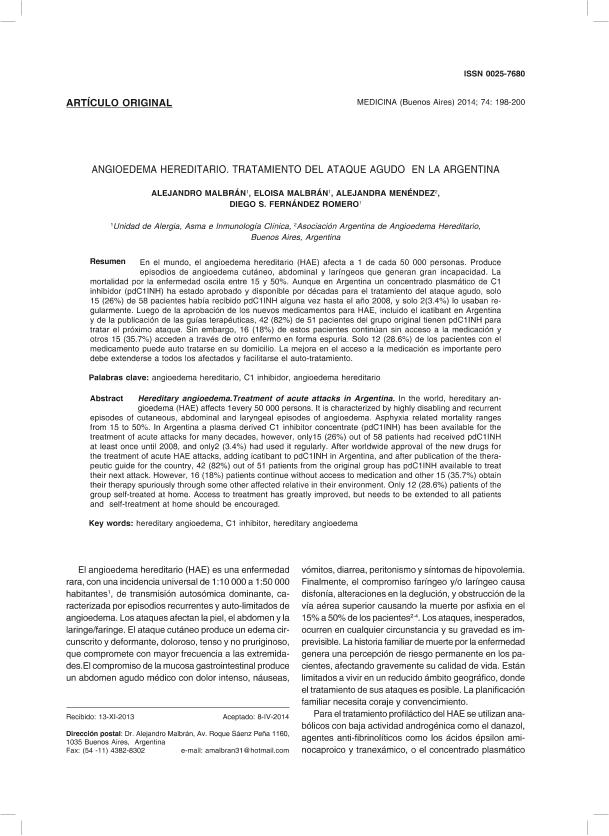Artículo
En el mundo, el angioedema hereditario (HAE) afecta a 1 de cada 50 000 personas. Produceepisodios de angioedema cutáneo, abdominal y laríngeos que generan gran incapacidad. Lamortalidad por la enfermedad oscila entre 15 y 50%. Aunque en Argentina un concentrado plasmático de C1inhibidor (pdC1INH) ha estado aprobado y disponible por décadas para el tratamiento del ataque agudo, solo15 (26%) de 58 pacientes había recibido pdC1INH alguna vez hasta el año 2008, y solo 2(3.4%) lo usaban regularmente.Luego de la aprobación de los nuevos medicamentos para HAE, incluido el icatibant en Argentinay de la publicación de las guías terapéuticas, 42 (82%) de 51 pacientes del grupo original tienen pdC1INH paratratar el próximo ataque. Sin embargo, 16 (18%) de estos pacientes continúan sin acceso a la medicación yotros 15 (35.7%) acceden a través de otro enfermo en forma espuria. Solo 12 (28.6%) de los pacientes con elmedicamento puede auto tratarse en su domicilio. La mejora en el acceso a la medicación es importante perodebe extenderse a todos los afectados y facilitarse el auto-tratamiento In the world, hereditary angioedema (HAE) affects 1every 50 000 persons. It is characterized by highly disabling and recurrent episodes of cutaneous, abdominal and laryngeal episodes of angioedema. Asphyxia related mortality ranges from 15 to 50%. In Argentina a plasma derived C1 inhibitor concentrate (pdC1INH) has been available for the treatment of acute attacks for many decades, however, only15 (26%) out of 58 patients had received pdC1INH at least once until 2008, and only2 (3.4%) had used it regularly. After worldwide approval of the new drugs for the treatment of acute HAE attacks, adding icatibant to pdC1INH in Argentina, and after publication of the therapeutic guide for the country, 42 (82%) out of 51 patients from the original group has pdC1INH available to treat their next attack. However, 16 (18%) patients continue without access to medication and other 15 (35.7%) obtain their therapy spuriously through some other affected relative in their environment. Only 12 (28.6%) patients of the group self-treated at home. Access to treatment has greatly improved, but needs to be extended to all patients and self-treatment at home should be encouraged.
Angioedema hereditario. Tratamiento del ataque agudo en la Argentina
Título:
Hereditary angioedema.Treatment of acute attacks in Argentina
Fecha de publicación:
06/2014
Editorial:
Fundación Revista Medicina
Revista:
Medicina (Buenos Aires)
ISSN:
0025-7680
e-ISSN:
1669-9106
Idioma:
Español
Tipo de recurso:
Artículo publicado
Clasificación temática:
Resumen
Palabras clave:
Angioedema Hereditario
,
C1 Inhibidor
,
Ataque Agudo
Archivos asociados
Licencia
Identificadores
Colecciones
Articulos(SEDE CENTRAL)
Articulos de SEDE CENTRAL
Articulos de SEDE CENTRAL
Citación
Malbrán, Alejandro; Malbran, Eloisa; Menéndez, Alejandra; Fernández Romero, Diego S.; Angioedema hereditario. Tratamiento del ataque agudo en la Argentina; Fundación Revista Medicina; Medicina (Buenos Aires); 74; 3; 6-2014; 198-200
Compartir




